Birds’ Flight Initiation Distance in Residential Areas of Beijing Are Lower than in Pristine Environments: Implications for the Conservation of Urban Bird Diversity
Abstract
1. Introduction
2. Materials and Methods
2.1. Study Area and Sampling Sites
2.2. Field Surveys
2.3. Variables Collection
2.3.1. Species Frequency
2.3.2. Individual Initial Conditions
2.3.3. External Environment Characteristics
2.4. Data Analysis
3. Results
3.1. Birds FID in Residential Area
3.2. Birds FID of Different Groups
3.3. Birds FID in Different Initial Conditions
3.4. Factors Influencing Birds FID
4. Discussion
4.1. Birds’ FID in Residential Areas
4.2. Individual Initial Conditions That Affect Birds’ FID
4.3. The Predictors of Birds’ FID among Environmental Characteristics
4.4. Cultivate Big Trees in Planning and Management
5. Conclusions
Supplementary Materials
Author Contributions
Funding
Institutional Review Board Statement
Informed Consent Statement
Data Availability Statement
Acknowledgments
Conflicts of Interest
References
- Petrelli, A.R.; Levenhagen, M.J.; Wardle, R.; Barber, J.R.; Francis, C.D. First to Flush: The Effects of Ambient Noise on Songbird Flight Initiation Distances and Implications for Human Experiences with Nature. Front. Ecol. Evol. 2017, 5, 67. [Google Scholar] [CrossRef]
- Morelli, F.; Mikula, P.; Benedetti, Y.; Bussière, R.; Jerzak, L.; Tryjanowski, P. Escape behaviour of birds in urban parks and cemeteries across Europe: Evidence of behavioural adaptation to human activity. Sci. Total Environ. 2018, 631–632, 803–810. [Google Scholar] [CrossRef] [PubMed]
- Hall, M.J.; Burns, A.L.; Martin, J.M.; Hochuli, D.F. Flight initiation distance changes across landscapes and habitats in a successful urban coloniser. Urban Ecosyst. 2020, 23, 785–791. [Google Scholar] [CrossRef]
- Gendall, J.; Lill, A.; Beckman, J. Tolerance of disturbance by humans in long-time resident and recent colonist urban doves. Avian Res. 2015, 6, 7. [Google Scholar] [CrossRef]
- Samia, D.S.M.; Blumstein, D.T.; Díaz, M.; Grim, T.; Ibáñez-Álamo, J.D.; Jokimäki, J.; Tätte, K.; Markó, G.; Tryjanowski, P.; Møller, A.P. Rural-Urban Differences in Escape Behavior of European Birds across a Latitudinal Gradient. Front. Ecol. Evol. 2017, 5, 66. [Google Scholar] [CrossRef]
- van Donselaar, J.L.; Atma, J.L.; Kruyf, Z.A.; LaCroix, H.N.; Proppe, D.S. Urbanization alters fear behavior in black-capped chickadees. Urban Ecosyst. 2018, 21, 1043–1051. [Google Scholar] [CrossRef]
- Andrade, M.; Blumstein, D.T. Anti-predator behavior along elevational and latitudinal gradients in dark-eyed juncos. Curr. Zool. 2020, 66, 239–245. [Google Scholar] [CrossRef]
- Charuvi, A.; Lees, D.; Glover, H.K.; Rendall, A.R.; Dann, P.; Weston, M.A. A physiological cost to behavioural tolerance. Behav. Process. 2020, 181, 104250. [Google Scholar] [CrossRef]
- Coetzer, C.; Bouwman, H. Waterbird flight initiation distances at Barberspan Bird Sanctuary, South Africa. Koedoe 2017, 59, a1419. [Google Scholar] [CrossRef]
- Dowling, L.; Bonier, F. Should I stay, or should I go: Modeling optimal flight initiation distance in nesting birds. PLoS ONE 2018, 13, e0208210. [Google Scholar] [CrossRef]
- McFadden, T.N.; Herrera, A.G.; Navedo, J.G. Waterbird responses to regular passage of a birdwatching tour boat: Implications for wetland management. J. Nat. Conserv. 2017, 40, 42–48. [Google Scholar] [CrossRef]
- Prestes, T.V.; Manica, L.T.; de Guaraldo, A.C. Behavioral responses of urban birds to human disturbance in urban parks at Curitiba, Paraná (Brazil). Rev. Bras. Ornitol. 2018, 26, 77–81. [Google Scholar] [CrossRef]
- Weston, M.A.; McLeod, E.M.; Blumstein, D.T.; Guay, P.-J. A review of flight-initiation distances and their application to managing disturbance to Australian birds. Emu–Austral Ornithol. 2012, 112, 269–286. [Google Scholar] [CrossRef]
- Feng, C.; Liang, W. Behavioral responses of black-headed gulls (Chroicocephalus ridibundus) to artificial provisioning in China. Glob. Ecol. Conserv. 2020, 21, e00873. [Google Scholar] [CrossRef]
- Bateman, P.W.; Fleming, P.A. Who are you looking at? Hadeda ibises use direction of gaze, head orientation and approach speed in their risk assessment of a potential predator. J. Zool. 2011, 285, 316–323. [Google Scholar] [CrossRef]
- Bötsch, Y.; Gugelmann, S.; Tablado, Z.; Jenni, L. Effect of human recreation on bird anti-predatory response. PeerJ 2018, 6, e5093. [Google Scholar] [CrossRef]
- Díaz, M.; Møller, A.P.; Flensted-Jensen, E.; Grim, T.; Ibáñez-Álamo, J.D.; Jokimäki, J.; Markó, G.; Tryjanowski, P. The geography of fear: A latitudinal gradient in anti-predator escape distances of birds across Europe. PLoS ONE 2013, 8, e64634. [Google Scholar] [CrossRef]
- Møller, A.P. The value of a mouthful: Flight initiation distance as an opportunity cost. Eur. J. Ecol. 2015, 1, 43–51. [Google Scholar] [CrossRef]
- Lin, T.; Coppack, T.; Lin, Q.-X.; Kulemeyer, C.; Schmidt, A.; Behm, H.; Luo, T. Does avian flight initiation distance indicate tolerance towards urban disturbance? Ecol. Indic. 2012, 15, 30–35. [Google Scholar] [CrossRef]
- Chamaillé-Jammes, S.; Blumstein, D.T. A case for quantile regression in behavioral ecology: Getting more out of flight initiation distance data. Behav. Ecol. Sociobiol. 2012, 66, 985–992. [Google Scholar] [CrossRef]
- Mikula, P.; Díaz, M.; Møller, A.P.; Albrecht, T.; Tryjanowski, P.; Hromada, M. Migratory and resident waders differ in risk taking on the wintering grounds. Behav. Process. 2018, 157, 309–314. [Google Scholar] [CrossRef]
- Fleming, P.A.; Bateman, P.W. Scavenging Opportunities Modulate Escape Responses over a Small Geographic Scale. Ethology 2017, 123, 205–212. [Google Scholar] [CrossRef]
- Stansell, H.M.; Blumstein, D.T.; Yeh, P.J.; Nonacs, P. Individual variation in tolerance of human activity by urban dark-eyed juncos (Junco hyemalis). Wilson J. Ornithol. 2020, 134, 43–51. [Google Scholar] [CrossRef] [PubMed]
- Tätte, K.; Møller, A.P.; Mänd, R. Towards an integrated view of escape decisions in birds: Relation between flight initiation distance and distance fled. Anim. Behav. 2018, 136, 75–86. [Google Scholar] [CrossRef]
- Zhou, B.; Liang, W. Avian escape responses to observers wearing clothing of different colors: A comparison of urban and rural populations. Glob. Ecol. Conserv. 2020, 22, e00921. [Google Scholar] [CrossRef]
- Bernard, G.E.; van Dongen, W.F.D.; Guay, P.-J.; Symonds, M.R.E.; Robinson, R.W.; Weston, M.A. Bicycles evoke longer flight-initiation distances and higher intensity escape behaviour of some birds in parks compared with pedestrians. Landsc. Urban Plan. 2018, 178, 276–280. [Google Scholar] [CrossRef]
- Glover, H.K.; Guay, P.-J.; Weston, M.A. Up the creek with a paddle; avian flight distances from canoes versus walkers. Wetl. Ecol. Manag. 2015, 23, 775–778. [Google Scholar] [CrossRef]
- McLeod, E.M.; Guay, P.-J.; Taysom, A.J.; Robinson, R.W.; Weston, M.A. Buses, cars, bicycles and walkers: The influence of the type of human transport on the flight responses of waterbirds. PLoS ONE 2013, 8, e82008. [Google Scholar] [CrossRef]
- Vines, A.; Lill, A. Boldness and urban dwelling in little ravens. Wildl. Res. 2015, 42, 590. [Google Scholar] [CrossRef]
- Battle, K.E.; Foltz, S.L.; Moore, I.T. Predictors of flight behavior in rural and urban songbirds. Wilson J. Ornithol. 2016, 128, 510–519. [Google Scholar] [CrossRef]
- Guay, P.-J.; Lorenz, R.D.A.; Robinson, R.W.; Symonds, M.R.E.; Weston, M.A. Distance from Water, Sex and Approach Direction Influence Flight Distances Among Habituated Black Swans. Ethology 2013, 119, 552–558. [Google Scholar] [CrossRef]
- Legagneux, P.; Ducatez, S. European birds adjust their flight initiation distance to road speed limits. Biol. Lett. 2013, 9, 20130417. [Google Scholar] [CrossRef] [PubMed]
- Slater, C.; Cam, G.; Qi, Y.; Liu, Y.; Guay, P.-J.; Weston, M.A. Camera shy? Motivations, attitudes and beliefs of bird photographers and species-specific avian responses to their activities. Biol. Conserv. 2019, 237, 327–337. [Google Scholar] [CrossRef]
- Jiang, X.; Liu, J.; Zhang, C.; Liang, W. Face masks matter: Eurasian tree sparrows show reduced fear responses to people wearing face masks during the COVID-19 pandemic. Glob. Ecol. Conserv. 2020, 24, e01277. [Google Scholar] [CrossRef]
- Carrete, M.; Tella, J.L. Inter-individual variability in fear of humans and relative brain size of the species are related to contemporary urban invasion in birds. PLoS ONE 2011, 6, e18859. [Google Scholar] [CrossRef]
- Davey, S.; Massaro, M.; Freire, R. Differences in flight initiation distance (FID) between rural and urban populations of two species of Australian birds. Behaviour 2019, 156, 1151–1164. [Google Scholar] [CrossRef]
- Bjørvik, L.M.; Dale, S.; Hermansen, G.H.; Munishi, P.K.T.; Moe, S.R. Bird flight initiation distances in relation to distance from human settlements in a Tanzanian floodplain habitat. J. Ornithol. 2015, 156, 239–246. [Google Scholar] [CrossRef]
- Møller, A.P. Basal metabolic rate and risk-taking behaviour in birds. J. Evol. Biol. 2009, 22, 2420–2429. [Google Scholar] [CrossRef]
- Møller, A.P.; Garamszegi, L.Z. Between individual variation in risk-taking behavior and its life history consequences. Behav. Ecol. 2012, 23, 843–853. [Google Scholar] [CrossRef]
- Blumstein, D.T.; Fernandez-Juricic, E.; LeDee, O.; Larsen, E.; Rodriguez-Prieto, I.; Zugmeyer, C. Avian Risk Assessment: Effects of Perching Height and Detectability. Ethology 2004, 110, 273–285. [Google Scholar] [CrossRef]
- Blumstein, D.T. Developing an evolutionary ecology of fear: How life history and natural history traits affect disturbance tolerance in birds. Anim. Behav. 2006, 71, 389–399. [Google Scholar] [CrossRef]
- Huang, Y.; Zhao, Y.; Li, S.; von Gadow, K. The Effects of habitat area, vegetation structure and insect richness on breeding bird populations in Beijing urban parks. Urban For. Urban Green. 2015, 14, 1027–1039. [Google Scholar] [CrossRef]
- Bates, D.; Mächler, M.; Bolker, B.; Walker, S. Fitting Linear Mixed-Effects Models Using Lme4. arXiv 2015, arXiv:1406.5823. [Google Scholar]
- Bartoń, K. MuMIn: Multi-Model Inference. 2020. Available online: https://CRAN.R-project.org/package=MuMIn (accessed on 11 November 2022).
- Mazerolle, M.J. AICcmodavg: Model Selection and Multimodel Inference Based on (Q)AIC(c). 2020. Available online: https://cran.r-project.org/package=AICcmodavg (accessed on 11 November 2022).
- Gordon, M.; Lumley, T. Forestplot: Advanced Forest Plot Using ‘Grid’ Graphics. 2020. Available online: https://CRAN.R-project.org/package=forestplot (accessed on 11 November 2022).
- Mayer, M.; Natusch, D.; Frank, S. Water body type and group size affect the flight initiation distance of European waterbirds. PLoS ONE 2019, 14, e0219845. [Google Scholar] [CrossRef] [PubMed]
- Mikula, P. Pedestrian Density Influences Flight Distances of Urban Birds. Ardea 2014, 102, 53–60. [Google Scholar] [CrossRef]
- Piratelli, A.J.; Favoretto, G.R.; de Almeida Maximiano, M.F. Factors affecting escape distance in birds. Zoologia 2015, 32, 438–444. [Google Scholar] [CrossRef]
- Blumstein, D.T.; Anthony, L.L.; Harcourt, R.; Ross, G. Testing a key assumption of wildlife buffer zones: Is flight initiation distance a species-specific trait? Biol. Conserv. 2003, 110, 97–100. [Google Scholar] [CrossRef]
- Jiang, Y.; Møller, A.P. Antipredator escape distances of common and threatened birds. Behav. Ecol. 2017, 28, 1498–1503. [Google Scholar] [CrossRef]
- Collop, C.; Stillman, R.A.; Garbutt, A.; Yates, M.G.; Rispin, E.; Yates, T. Variability in the area, energy and time costs of wintering waders responding to disturbance. Ibis 2016, 158, 711–725. [Google Scholar] [CrossRef]
- Poddubnaya, N.; Korotkova, T.; Vanicheva, P. Increasing corvid tolerance to humans in urban ecosystems with increasing latitude. Biol. Commun. 2020, 64. [Google Scholar] [CrossRef]
- Morelli, F.; Benedetti, Y.; Díaz, M.; Grim, T.; Ibáñez-Álamo, J.D.; Jokimäki, J.; Kaisanlahti-Jokimäki, M.; Tätte, K.; Markó, G.; Jiang, Y.; et al. Contagious fear: Escape behavior increases with flock size in European gregarious birds. Ecol. Evol. 2019, 9, 6096–6104. [Google Scholar] [CrossRef] [PubMed]
- Chen, X.-M.; Xie, W.-T.; Shuai, L.-Y. Flush early and avoid the rush? It may depend on where you stand. Ethology 2020, 126, 987–992. [Google Scholar] [CrossRef]
- Osorio-Beristain, M.; Rodríguez, A.; Martínez-Garza, C.; Alcalá, R.E. Relating flight initiation distance in birds to tropical dry forest restoration. Zoologia 2018, 35, 1–6. [Google Scholar] [CrossRef]
- Gravolin, I.; Key, M.; Lill, A. Boldness of Urban Australian Magpies and Local Traffic Volume. Avian Biol. Res. 2014, 7, 244–250. [Google Scholar] [CrossRef]
- Jablonszky, M.; Szász, E.; Markó, G.; Török, J.; Herczeg, G.; Garamszegi, L.Z. Escape ability and risk-taking behaviour in a Hungarian population of the collared flycatcher (Ficedula albicollis). Behav. Ecol. Sociobiol. 2017, 71, 54. [Google Scholar] [CrossRef]
- Vincze, E.; Papp, S.; Preiszner, B.; Seress, G.; Bókony, V.; Liker, A. Habituation to human disturbance is faster in urban than rural house sparrows. Behav. Ecol. 2016, 27, 1304–1313. [Google Scholar] [CrossRef]
- Jiang, Y.; Møller, A.P. Escape from predators and genetic variance in birds. J. Evol. Biol. 2017, 30, 2059–2067. [Google Scholar] [CrossRef]
- García-Arroyo, M.; MacGregor-Fors, I. Tolerant to humans? Assessment of alert and flight initiation distances of two bird species in relation to sex, flock size, and environmental characteristics. Ethol. Ecol. Evol. 2020, 32, 445–456. [Google Scholar] [CrossRef]
- Jiao, M.; Xue, H.; Yan, J.; Zheng, Z.; Wang, J.; Zhao, C.; Zhang, L.; Zhou, W. Tree abundance, diversity and their driving and indicative factors in Beijing’s residential areas. Tree abundance, diversity and their driving and indicative factors in Beijing’s residential areas. Ecol. Indic. 2021, 125, 107462. [Google Scholar] [CrossRef]
- Yin, L.; Wang, C.; Han, W. Food source characteristics and diversity of birds based on feeding behavior in residential areas of Beijing. Biodivers. Sci. 2022. [Google Scholar] [CrossRef]
- Li, X.; Jia, B.; Zhang, W.; Ma, J.; Liu, X. Woody plant diversity spatial patterns and the effects of urbanization in Beijing, China. Urban For. Urban Green. 2020, 56, 126873. [Google Scholar] [CrossRef]
- Sachs, A.L.; Boag, A.E.; Troy, A. Valuing urban trees: A hedonic investigation into tree canopy influence on property values across environmental and social contexts in Baltimore, Maryland. Urban For. Urban Green. 2023, 80, 127829. [Google Scholar] [CrossRef]
- Chin, M.; Ruppert, W.; Shrestha, N.; Fortin, M. Urban Avian Conservation Planning Using Species Functional Traits and Habitat Suitability Mapping. Land 2022, 11, 1831. [Google Scholar] [CrossRef]
- Amaya-Espinel, J.D.; Hostetler, M.E. The value of small forest fragments and urban tree canopy for Neotropical migrant birds during winter and migration seasons in Latin American countries: A systematic review. Landsc. Urban Plan. 2019, 190, 103592. [Google Scholar] [CrossRef]
- Speak, A.F.; Salbitano, F. The impact of pruning and mortality on urban tree canopy volume. Urban For. Urban Green. 2023, 79, 127810. [Google Scholar] [CrossRef]
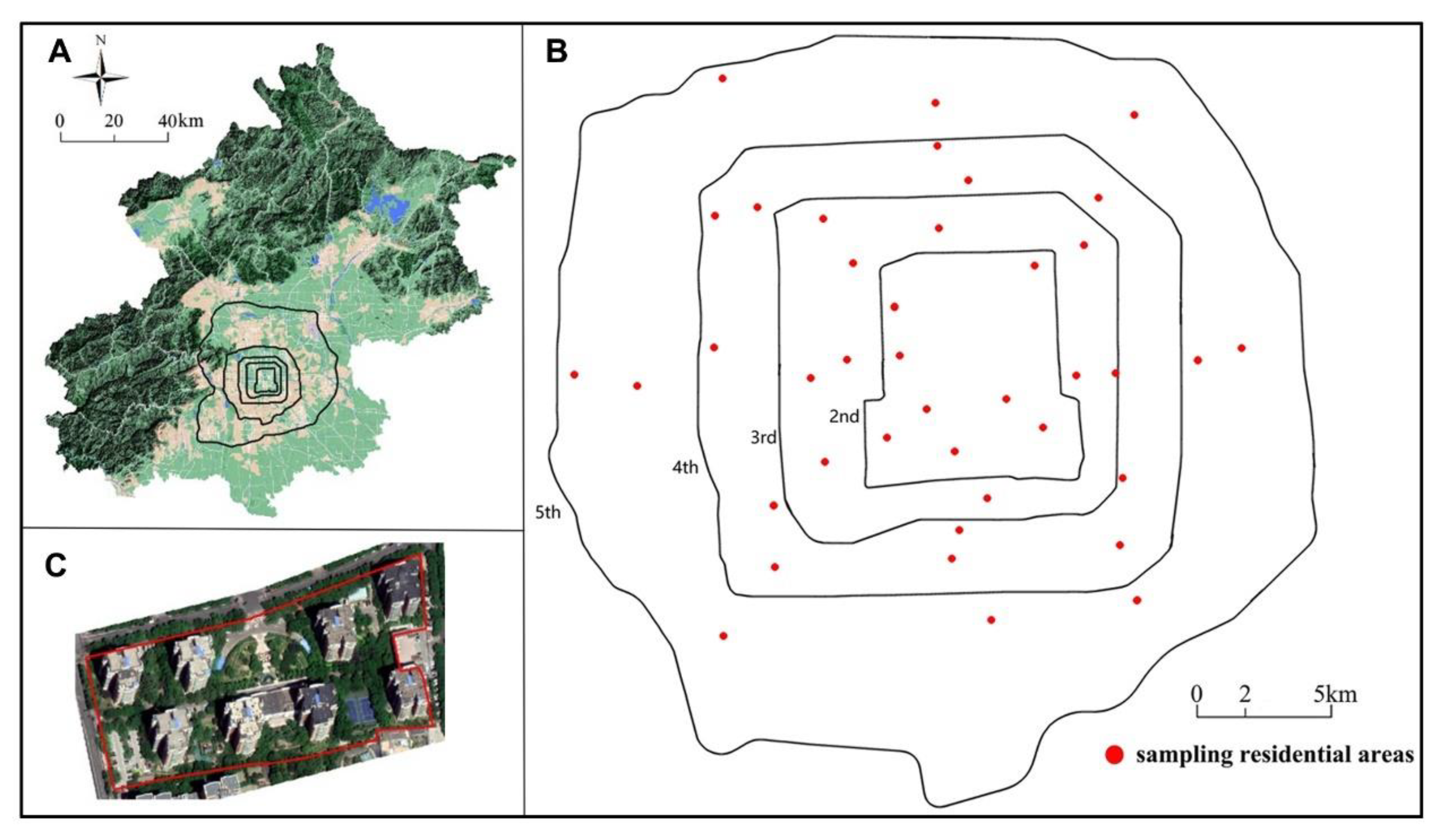
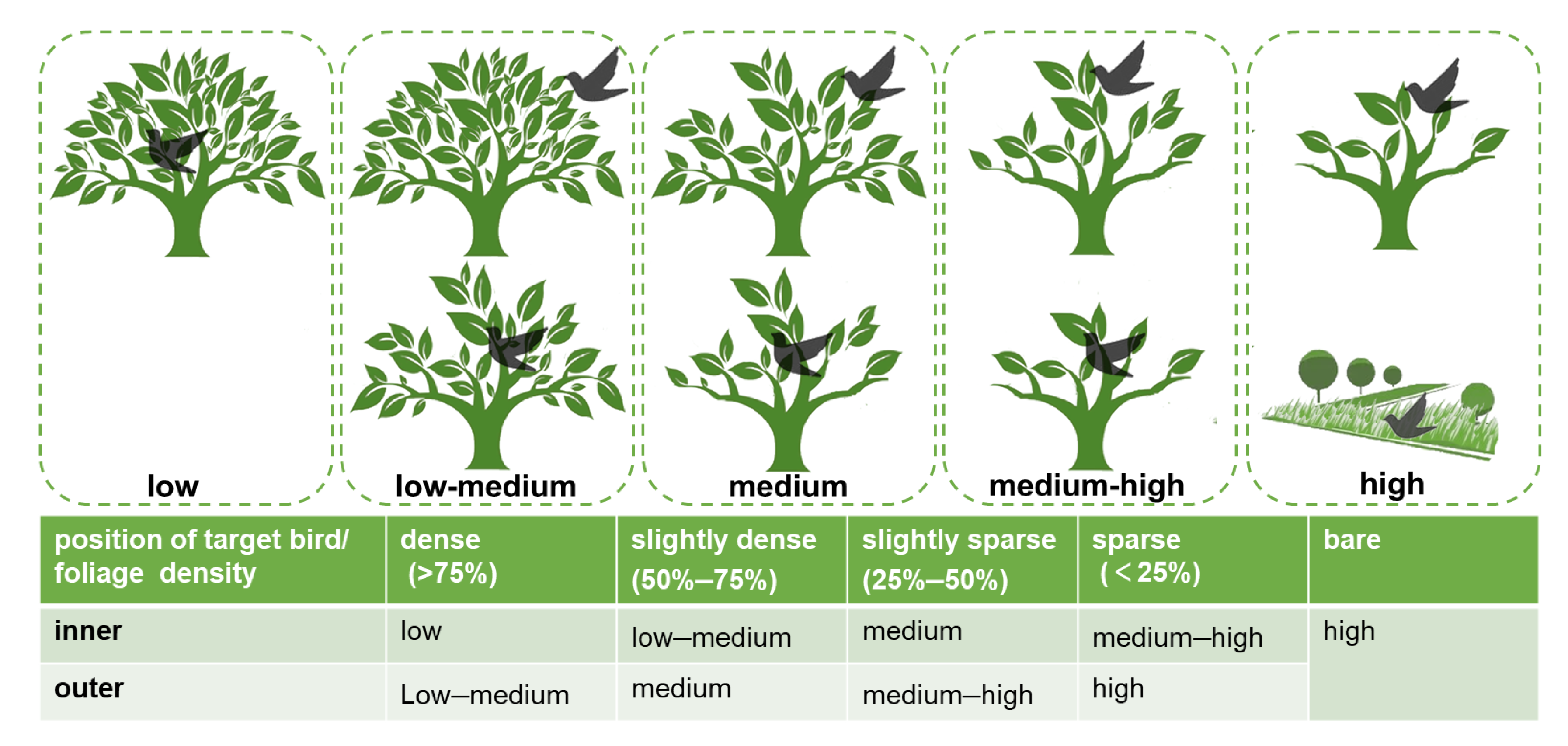
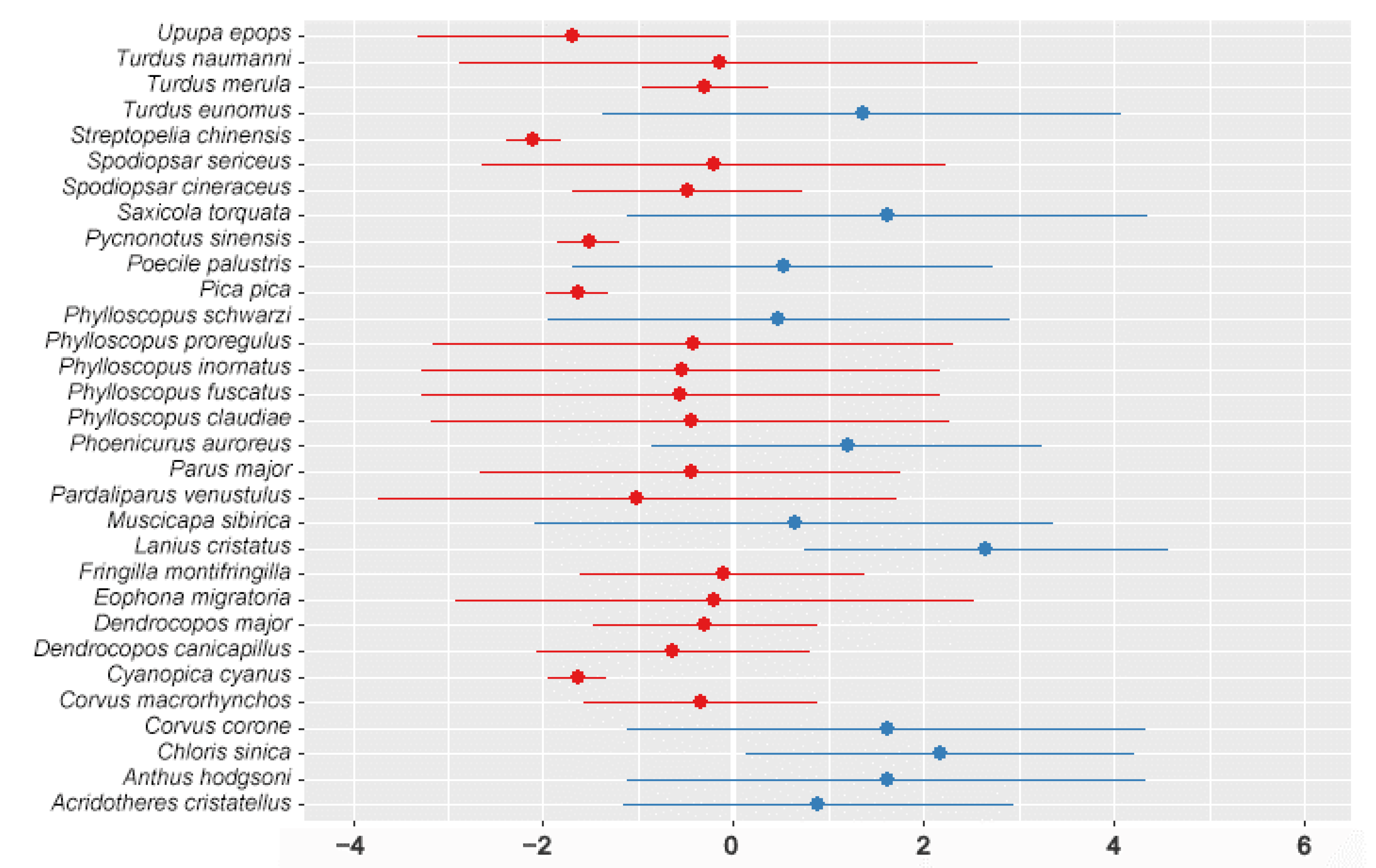

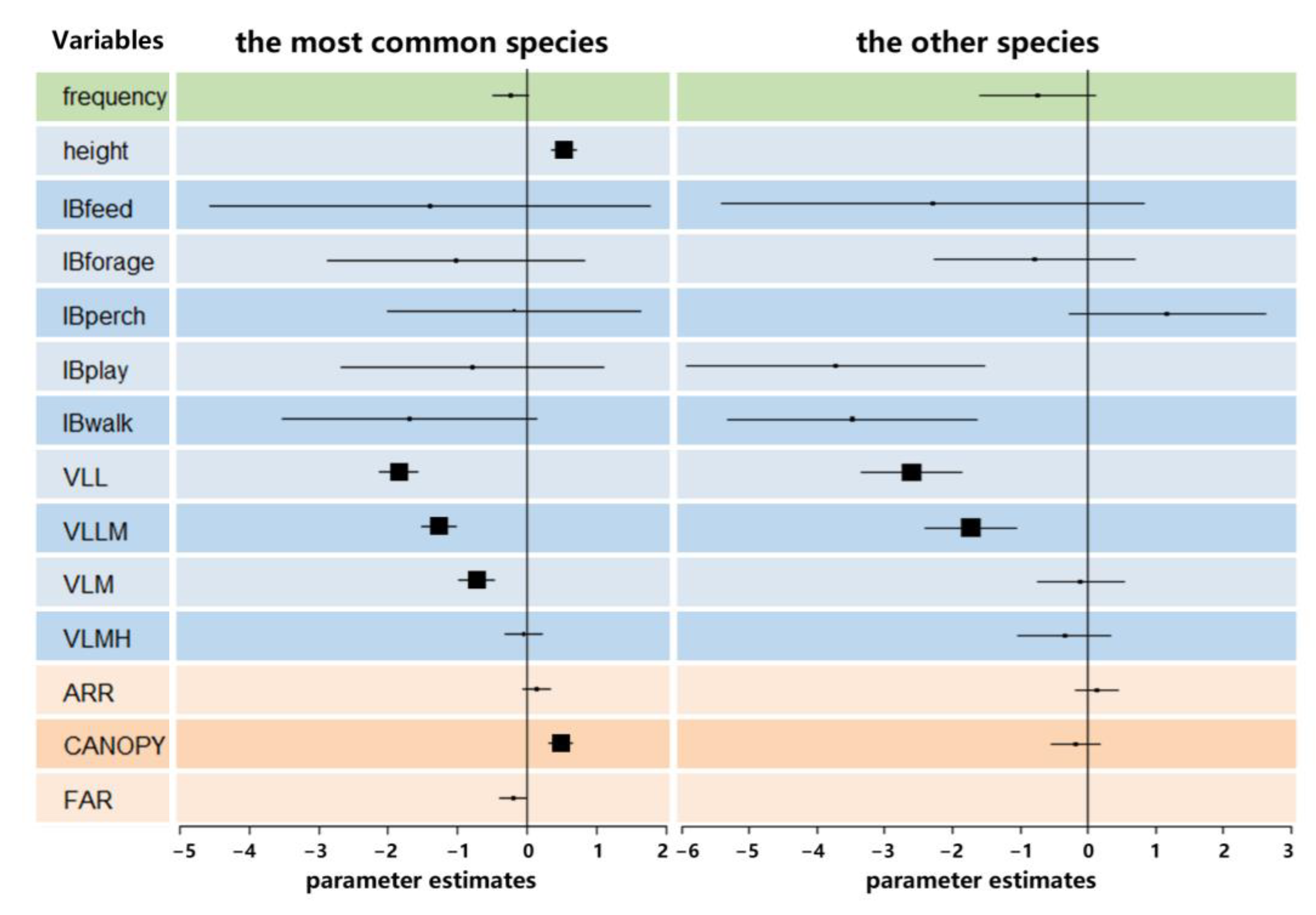
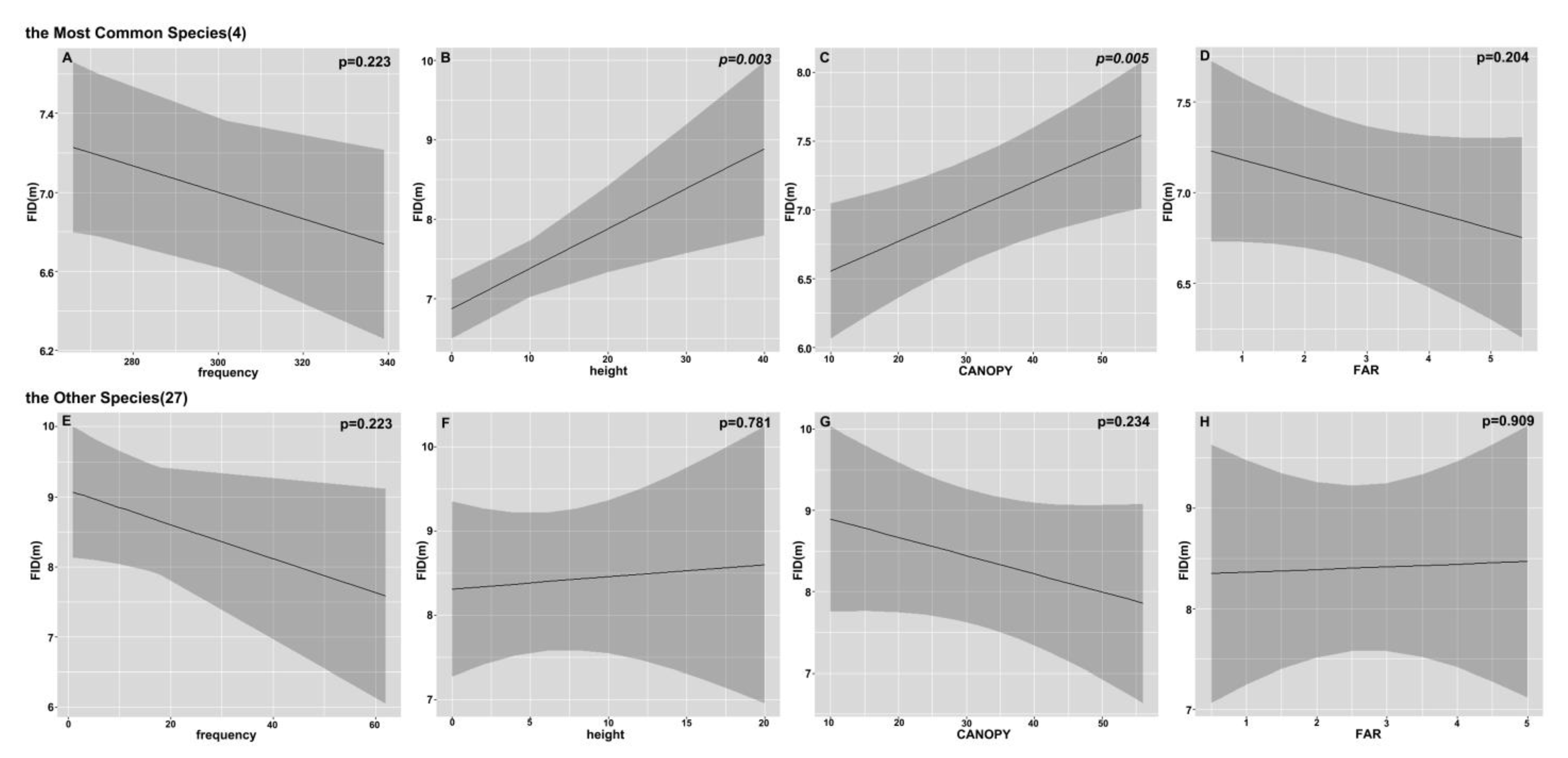
| Type | Variables | Description |
|---|---|---|
| Species frequency | Frequency | Total individuals of each species recorded during the survey reflecting species frequency |
| Individual initial condition | Initial behaviour (IB) | Initial behaviour of the target bird. |
| Height(m) | Initial height of the target bird off the ground. | |
| Visibility level (VL) | Initial visibility of the target bird (Figure 2). | |
| External environment characteristic | Floor area ratio (FAR) | The total floor area is divided by the area of each site. |
| Adjacent roads ratio (%) (ARR) | The length of urban main and secondary roads is divided by the perimeter of each site. | |
| Tree canopy coverage (%) (CANOPY) | The area covered by the tree canopy is divided by the area of each site. |
Disclaimer/Publisher’s Note: The statements, opinions and data contained in all publications are solely those of the individual author(s) and contributor(s) and not of MDPI and/or the editor(s). MDPI and/or the editor(s) disclaim responsibility for any injury to people or property resulting from any ideas, methods, instructions or products referred to in the content. |
© 2023 by the authors. Licensee MDPI, Basel, Switzerland. This article is an open access article distributed under the terms and conditions of the Creative Commons Attribution (CC BY) license (https://creativecommons.org/licenses/by/4.0/).
Share and Cite
Yin, L.; Wang, C.; Han, W.; Zhang, C. Birds’ Flight Initiation Distance in Residential Areas of Beijing Are Lower than in Pristine Environments: Implications for the Conservation of Urban Bird Diversity. Sustainability 2023, 15, 4994. https://doi.org/10.3390/su15064994
Yin L, Wang C, Han W, Zhang C. Birds’ Flight Initiation Distance in Residential Areas of Beijing Are Lower than in Pristine Environments: Implications for the Conservation of Urban Bird Diversity. Sustainability. 2023; 15(6):4994. https://doi.org/10.3390/su15064994
Chicago/Turabian StyleYin, Luqin, Cheng Wang, Wenjing Han, and Chang Zhang. 2023. "Birds’ Flight Initiation Distance in Residential Areas of Beijing Are Lower than in Pristine Environments: Implications for the Conservation of Urban Bird Diversity" Sustainability 15, no. 6: 4994. https://doi.org/10.3390/su15064994
APA StyleYin, L., Wang, C., Han, W., & Zhang, C. (2023). Birds’ Flight Initiation Distance in Residential Areas of Beijing Are Lower than in Pristine Environments: Implications for the Conservation of Urban Bird Diversity. Sustainability, 15(6), 4994. https://doi.org/10.3390/su15064994





